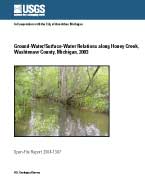

 |
Ground-Water/Surface-Water Relations along Honey Creek, Washtenaw County, Michigan, 2003By Denis F. HealyPrepared in Cooperation with the City of Ann Arbor, MichiganOpen-File Report 2004-1387 |
This report is presented in Portable Document Format (PDF).
Printable cover (757 KB)--1 page
Left inside cover (15 KB)--1 page
Right inside cover (14 KB)--1 page
Report (936 KB)--21 pages
The citation for this report, in USGS format, is as follows:
Healy, D.F., 2005, Ground-Water/Surface-Water Relations along Honey Creek, Washtenaw County, Michigan, 2003: U.S. Geological Survey Open-File Report 2004-1387, 17 p.
For more information about USGS activities in Michigan, visit the USGS MI Water Science Center Home Page.
The U.S. Geological Survey (USGS), in cooperation with the city of Ann Arbor, Mich., investigated the ground-water/surface-water relations along the lower reaches of Honey Creek, Washtenaw County, Mich., and an unnamed tributary to Honey Creek (the discharge tributary) from June through October 2003. Streamflow in these reaches was artificially high during a naturally low-flow period due to an anthropogenic discharge. Ground-water/surface-water relations were examined by seepage runs (series of streamflow measurements for the computation of streams gains or losses) and measurements of the difference in head between the stream surface and shallow aquifer. Specific conductance and water-temperature measurements were used as ancillary data to help identify gaining and losing reaches. Three seepage runs and four runs in which hydraulic-head differences between the stream and shallow aquifer were measured (piezometer runs) were made during periods of base flow.
Streamflow measurements were made at 18 sites for the seepage runs. Instream piezometers were installed at 16 sites and bank piezometers were installed at 2 sites. Two deeper instream piezometers were installed at site 13 on September 4, 2003 to collect additional data on the ground-water/surface-water relations at that site.
The seepage runs indicate that the main stem of Honey Creek and the discharge tributary in the study area are overall gaining reaches. The seepage runs also indicate that smaller reaches of Honey Creek and the discharge tributary may be losing reaches and that this relation may change over time with changing hydraulic conditions. The piezometer-run measurements support the seepage-run results on the main stem, whereas piezometer-run measurements both support and conflict with seepage-run measurements on the discharge tributary. Seepage runs give an average for the reach, whereas piezometer head-difference measurements are for a specific area around the piezometer. Data that may appear to be conflicting actually may be showing that within a gaining reach there are localized areas that lose streamflow
The overall gain in streamflow along with specific measurements of head differences, specific conductance, and water temperature indicate that ground water is discharging to Honey Creek and the discharge tributary. Although reaches and areas that lose streamflow have been identified, data collected during this study cannot confirm or disprove that the loss is to the regional ground-water system.
Abstract
Introduction
Purpose and Scope
Study area
Methods of investigation
Seepage runs
Piezometer measurements
Hydraulic head
Specific conductance and water temperature
Ground-water/surface-water relations
Seepage runs
Piezometer measurements
Head difference
Specific conductance and water temperature
Comparison of results of seepage runs and piezometer measurements
Summary and conclusions
Acknowledgments
References
Appendix 1. Seepage-run and piezometer-run measurements
Table 1-1. Streamflow measurements for the July 16 and July 29, 2003, seepage runs, Honey Creek, Washtenaw County, Mich.
Table 1-2. Head, specific conductance, and water-temperature measurements from the July 10, July 16, and July 29, 2003, piezometer runs, Honey Creek, Washtenaw County, Mich.
1. Map showing Honey Creek study area, Washtenaw Co., Michigan
2-3. Photographs showing:
2. Culvert, riprap, and drain downstream from the intersection of Zeeb Road with Honey Creek
3. Bridge at site 4, Honey Creek at Pratt Rd near Ann Arbor, Michigan
4. Schematic diagrams showing reaches of Honey Creek and statistically significant streamflow gain or loss as measured during seepage runs, 2003
A. June 18
B. August 20
C. September 10
1. Honey Creek study sites
2. Equations used to compute streamflow differences in study reaches
3. Streamflow measurements with magnitude and percent difference between sites
4. Head, specific conductance, and water temperature measurements at sites 1-15 with head difference
between stream and shallow aquifer
5. Head, specific conductance, and water-temperature measurements at site 13 with difference between
the stream and shallow aquifer during September and October 2003
| AccessibilityFOIAPrivacyPolicies and Notices | |
 |
|